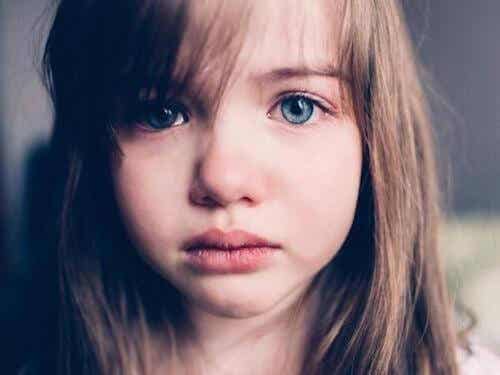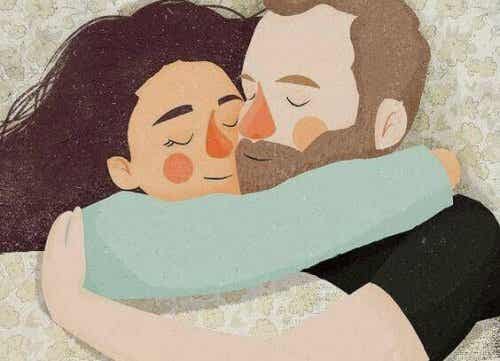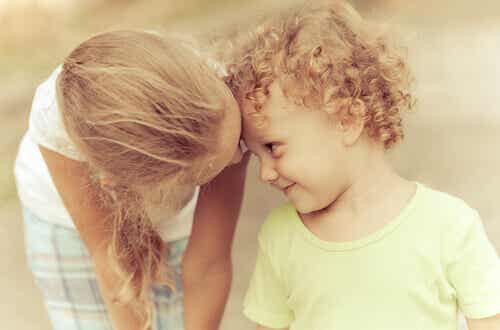
Last update: May 24, 2018
No one is exempt from sadness, not even the little ones. Losing someone, an unforeseen circumstance, a wasted opportunity ... Sadness in children is not an exception. For this, we must be there when they need us. Educating them in consciousness and emotional regulation is essential so that, later on, they are able to express their emotions.
The animated film Inside Out clarifies the importance of primary emotions in our life. Specifically, how to recognize and manifest sadness. Because they should teach us from an early age to channel despair, as well as fear, happiness or anger.
Help them understand what sadness is
When we meet someone who appears to be sad, we often tend to run away in the opposite direction. As if we are afraid that it will infect us and, for this reason, we prefer to be close to those who always have a smile on their lips. However, sadness in children, as in adults, is an essential and necessary emotion. And without it we could not understand happiness.
Although in adulthood it is more common to experience this emotion due to disagreements can happen, in children it is at least shocking. It is difficult to see a 5 year old sitting alone on a bench with a lost gaze or delving into his inner life. It is supposed that his innocence, his precarious intellectual maturity and his purely playful concerns should guarantee him indestructible happiness. But that may not be the case.
This is not to say that children do not have the right to be sick. They have it and, in fact, it is more common than we think, convenient at certain times and inevitable at many others. For example, they may feel melancholy over the loss of a family member or their dog, after changing schools, over a small quarrel with a friend ...
For this reason, the best way to help them is to talk to them about sadness, teach them to recognize and understand it. It is necessary to make him understand that it is better to acknowledge than to hide. That we all feel this way every now and then and that it is good to embrace this emotion to calm it down and let it pass.
Sadness in children: different manifestations
Like adults, even the little ones can express their mood in different ways. When they are having fun and are happy, it is normal for them to laugh, play and look cheerful. When they are frightened, they usually remain motionless, not speaking, until the fear has passed. When they are sad, however, the way they manifest this emotion is not very clear.
Sometimes they adopt opposite behaviors during the same day, which hide their real state of mind. Let's see some examples of how sadness manifests itself in children:
- Hypoactivity: they are depressed, apathetic, indifferent, not very talkative, inappetent and sleepyheads; they usually cry often, even for no good reason.
- Hyperactivity: They eat to excess, are anxious, do not want to sleep, are too talkative, etc.
In order to understand when sadness dominates, parents and guardians need to be especially alert to sudden changes in their behavior and mood.
How to help them deal with sadness
When we notice unusual or excessive behavior in the child, it is good to ask him why he is doing this. It is likely that he does not know how to explain it or, simply, does not want and prefers to withdraw into himself. However, we know that babies are like sponges in their early developmental stage.
Children learn from the emotional expressions of their parents, as they are their models of reference also in the emotional field. For this reason, it is convenient for parents to explain to them that everyone feels sad sooner or later. That it is normal and that even dad, mom, grandmother or uncle experience this feeling every now and then. They must also explain that it is an emotion which disappears when we can understand it, face it and accept it.
Through photographs of faces, drawings or simply by talking to them about sadness, their ability to recognize it can be strengthened. Once we have learned to recognize it, we can teach children how to deal with it by means of examples in which we ourselves simulate how to do it.
What doesn't help them
Unfortunately, dissembling is more fashionable than confronting. From an early age they teach us to change a tear for a smile and to suppress sadness. However, this does not make this emotion disappear, it only buries it, so that it comes back with more force at a later time.
- Mockery: The phrase "You are a crybaby" is terribly negative when a baby is crying. The only result that is obtained is to curb his emotional expressiveness, withdraw it, forcing him to hide it. It's a highly negative way of ridiculing his feelings.
- Put him in a hurry: When we ask him how he feels and does not respond, we often tend to push him and demand that he do so. The child, however, will only speak when he knows he can count on our support, regardless of how long it takes him. It is important that he feels listened to and supported at all times.
- Don't give it a damn: “It's nothing, it's nonsense. Do not do that". This doesn't help either, because the event that caused it is of great importance to him. We must try to reduce the possible pain or sadness it causes and not minimize its impact.
- Scold or punish him: "Since you continue to whimper, I punish you." With this sentence we are leaving him only one choice: that he stop crying and bear his sadness. Let's go back to point one. A hug, on the other hand, will help him feel tremendously good and full of strength and energy.
As we can see, the role of the people in his immediate environment is crucial for him to understand that he should not be afraid of being sad or of acknowledging that he is. Sadness in children must not go unnoticed.

























